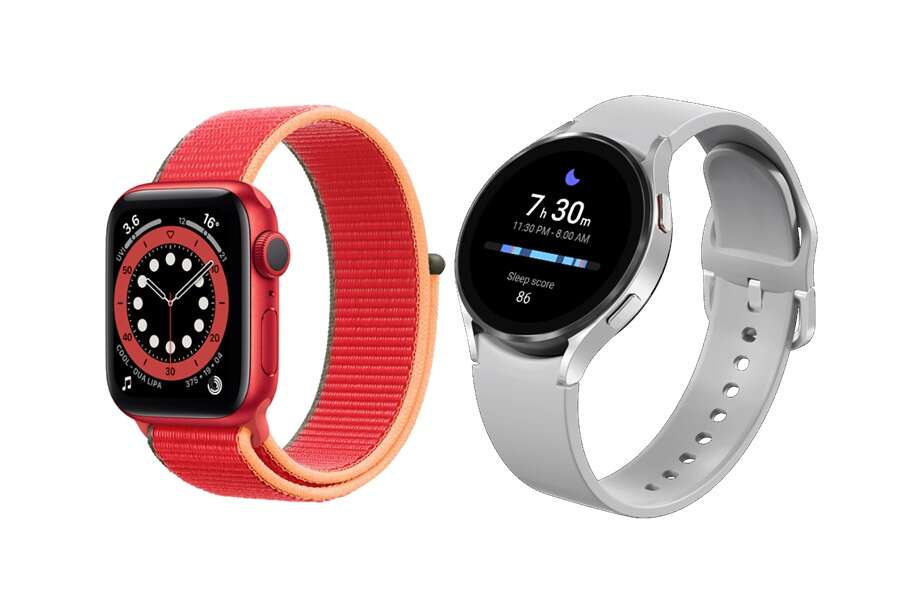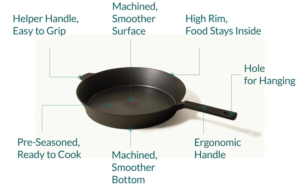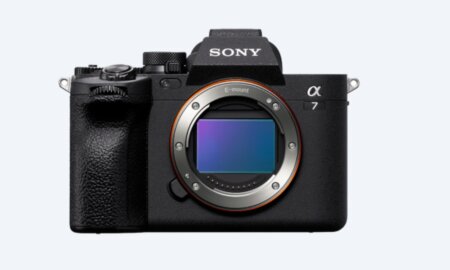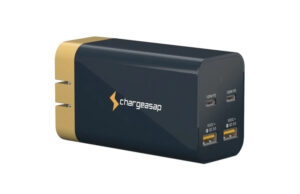This is a detailed comparison of the technical specifications between the Apple Watch Series 6 vs Samsung Galaxy Watch 4.
The main differences between the two watches are summarised in the following table:
| Apple Watch Series 6 | Samsung Galaxy Watch 4 |
| 10.7mm thick | 12.7mm thick |
| No IP Rating | IP68 Rating |
| 32GB | 16GB |
| 18 hours per charge (~24hrs actual) | 40 hours per charge (~24hrs actual) |
| No BIA Sensor | BIA Sensor |
| No Hall Sensor | Hall Sensor |
Thickness Issue
We were irritated when Samsung listed the watch thickness as “excluding sensors”, which do not make any sense. What matters is the entire thickness of the watch including sensors. When a manufacturer tries to “hide” their specifications, it usually means that the numbers are not pretty. Thanks to PCMag, the thickness is approximately half an inch or 12.7mm.
We have used Samsung Galaxy Active Watch 2 with 13.5mm thickness measured by vernier callipers, and it does not feel thick. The reason could be due to its lightweight and rounded corners. So even though it is thicker than Apple Watch 6, the thickness may not be a significant factor for some users, especially guys.
IP Rating
We feel that an official IP Rating is essential for any mobile device, especially for a smartwatch which also doubles as a modern-day sports watch.
For the Samsung watch, IP68 means it is tested to be dust-tight and can submerge long term underwater for a specified duration. According to Samsung,
This means they are water-resistant to up to 50 metres in depth for 10 minutes. They are now suitable for low-velocity and shallow-water activities, including swimming. You can enjoy more freedom to explore, stay connected, and capture the adventure.
However, there is quite an extensive list of “Do Nots”:
● Do not keep the device in water:
– for more than one hour;
– deeper than 10cm for more than 30 minutes; or
– deeper than 1.5 metres for more than 10 minutes.
● Do not expose the device to water moving with force, such as water running from a tap, hose or shower.
The list shows that the Samsung Watch 4 is not a rugged, military-grade smartwatch, which covers an even more extensive list of qualification tests.
Storage Size
Both watches should increase the storage space up to at least 64 GB. Apple’s 32GB is acceptable, but Samsung needs to be more generous than just 16GB. My antique Apple iPod, bought almost ten years ago, already has 16GB.
Battery Life
According to PCMag, Apple Watch 6’s battery life outperformed their specified 18 hours. They clocked 25.5 hours in their test.
Samsung Watch 4 underperformed as it only achieved about 24 hours instead of the 40 hours claimed by Samsung. As such, Apple Watch Series 6 vs Samsung Galaxy Watch 4 battery life can be considered quite close to each other. The actual battery life for individuals will also vary depending on their usage.
BIA Sensor and Hall Sensor
BIA stands for Bioelectrical Impedance Analysis Sensor, commonly used to measure body composition by passing small electrical currents in your body. Such a sensor is commonly used in measuring muscle, bone and visceral fats in a body composition scale. Generally, the scale readings are not highly accurate, but they can provide a form of estimation. You can read more about the accuracy in our discussion about visceral fat measurement using body composition scale.
Hall sensors are used for proximity sensing, positioning, speed detection, and current sensing applications. While Samsung stated that this sensor is included on the Galaxy Watch 4, Apple’s tech specs did not mention anything about proximity or hall sensor. As this is quite a typical sensor found on most phones, we tend to believe that Apple has included this sensor in Apple Watch 6.
Conclusion
There may not be any Samsung Galaxy Active 3, and Samsung Galaxy Watch 4 will be a new upgrade for Galaxy Active 2 users.
We selected Galaxy Active 2 over Apple Watch because it was almost half the price. However, the blood pressure and oxygen apps were not available until late 2020, even though the watch already has the hardware for ECG. Nevertheless, it was a long wait but worth the time, and it also saved us the money to buy the more expensive Apple Watch.
An important point to note is that the watch has to be compatible with the phone. This means Apple iPhone users should buy Apple Watch 6, and Samsung Galaxy phone users should buy Galaxy Watch 4. So the comparison should only matter if you buy the phone with the watch.
Below is the complete comparison table.
| Comparison Matrix | Apple Watch Series 6 | Samsung Galaxy Watch 4 | ||||
| Tech Specs | 40mm | 44mm | 40mm | 44mm | 42mm Classic | 46mm Classic |
| Size (Watch Face) | 40x34mm | 44x38mm | 40.4×39.3mm | 44.4×43.3mm | 41.5×41.5 | 45.5×45.5 |
| Thickness (incl. sensor) | 10.7mm | 10.7mm | 13.5mm | 13.5mm | 13.5mm | 13.5mm |
| Weight (no strap) | 30.5g (Aluminum) 39.7g (Stainless) 34.6g (Titanium) | 36.5g (Aluminum) 47.1g (Stainless) 41.3g (Titanium) | 26g (Alum.) | 30g (Alum.) | 47g (Stainless) | 52g (Stainless) |
| Chip | S6 SiP w/64-bit dual-core, W3, U1 | Exynos W920 Dual Core 1.18GHz | ||||
| Screen Resolution | 324 by 394 pixels 759 mm2 | 368 by 448 pixels 977 mm2 | 396×396(1.2″) | 450×450(1.4″) | 396×396(1.2″) | 450×450(1.4″) |
| Glass | Aluminum uses Ion X Glass Stainless & Titanium uses Sapphire Crystal | Corning® Gorilla® Glass DX+ | Corning® Gorilla® Glass DX+ | Corning® Gorilla® Glass DX | Corning® Gorilla® Glass DX | |
| Always On Display | Yes | Yes | ||||
| IP Rating | No | Yes, IP68 (MIL-STD-810G), 50m | ||||
| Water-Resistant | 50m, 164ft (ISO 22810:2010) | 50m, 164ft (5 ATM) for 10 mins | ||||
| Ram | 1GB | 1.5GB | ||||
| Storage | 32GB | 16GB | ||||
| Battery Size | 265.9 mAh | 303.8mAh | 247 mAh | 361 mAh | 247 mAh | 361 mAh |
| Battery Life | Up to 18 hours (actual ~24hrs) | Up to 40 hours (actual ~24hrs) | ||||
| Max Charging Wattage | 5W | 5W | ||||
| Charging Time | Approx. 1.5 hours | Up to 2 hours | ||||
| LTE | Yes, selected models | Yes, selected models | ||||
| Wi-Fi | 802.11b/g/n 2.4 & 5GHz | 802.11 a/b/g/n 2.4 & 5GHz | ||||
| Bluetooth | 5.0 BLE | 5.0 BLE | ||||
| GNSS | A-GPS, Glonass, Galileo. QZSS (Jpn) | A-GPS, Glonass and Galileo | ||||
| NFC | Yes | Yes | ||||
| Compass | Yes | Yes | ||||
| Altimeter | Yes | Yes | ||||
| Barometer | Yes | Yes | ||||
| Light sensor | Yes | Yes | ||||
| BIA Sensor | No | Yes | ||||
| Blood oxygen sensor | VO2Max, SpO2 | VO2Max, SpO2 | ||||
| Electrical heart sensor | Yes | Yes | ||||
| Optical heart sensor | Yes, 3rd Gen | Yes | ||||
| Hall sensor | No | No | Yes | |||
| Accelerometer | Up to 32 g with fall detection | Yes | ||||
| Gyroscope | Yes | Yes | ||||
| Speaker | Yes | Yes | ||||
| Microphone | Yes | Yes | ||||
| Payment | Apple Pay | Samsung Pay | ||||
| Emergency Call | Yes, need Phone/LTE | Yes, need Phone/LTE | ||||
| Emergency SOS | Yes, need LTE/Phone/Wi-Fi | Yes, need a Phone/LTE | ||||
| Fall Detection | Yes | Yes | ||||
| Warranty (years) | 1 or 2 years (depends on model) | 12 months | ||||






